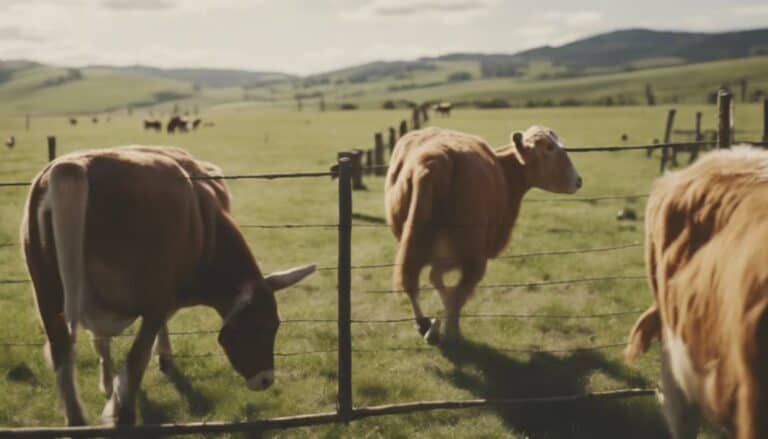You've seen how Farmer Brown increased his pasture productivity by implementing rotational grazing on his dairy farm. Now, imagine applying a systematic approach to grazing that not only benefits your livestock but also revitalizes your land. With a step-by-step guide to follow, you can streamline the process and guarantee success in your rotational grazing endeavors. By starting with evaluating your specific needs and land capacity, you lay the groundwork for a sustainable and efficient grazing system. But what comes next in this detailed guide? Stay tuned to uncover the essential steps for implementing rotational grazing effectively.
Key Takeaways
- Determine total animal units based on forage intake and grazing pressure.
- Calculate acres needed for grazing, considering supplemental forage and soil.
- Establish paddock size to meet livestock's forage needs.
- Ensure water access in every paddock for efficient grazing.
- Set stocking rates based on forage availability and monitor grazing heights.
Assessing Livestock Needs and Land Capacity
To accurately assess your livestock needs and land capacity for implementing a rotational grazing system, begin by determining the total animal units of your herd based on the daily forage intake of each livestock species and class.
By calculating the animal units for your herd, which could be influenced by factors like herd size and the types of livestock you have, you can better understand the grazing pressure on your pastures.
This knowledge will help you estimate the acres needed for grazing throughout the season, taking into account variables such as pasture growth, available forage, supplemental forage requirements, and soil characteristics.
Understanding these aspects is essential for managing your rotational grazing system effectively and ensuring that your livestock have enough quality forage while maintaining the health of your pastures for long-term sustainability.
Remember to take into account the specific needs of each animal class to tailor your grazing plan accordingly and optimize your land use.
Calculating Paddock Size and Number
When determining the appropriate paddock size and number for your rotational grazing system, consider the factors of animal unit requirements, available pasture space, and desired grazing duration.
Paddock size plays a vital role in ensuring that your livestock's forage needs are met adequately. Calculating the paddock size based on animal unit requirements and pasture growth is essential.
Larger animal units will require larger paddocks to sustain their forage needs effectively. Adequate paddock size not only supports proper grazing rotation but also allows for sufficient pasture recovery.
It's important to adjust both paddock size and number based on herd dynamics and seasonal changes. By considering these factors, you can establish a grazing system that aligns with your livestock's needs and promotes efficient pasture utilization.
Establishing Water Management Plan
Establish a thorough water management plan to guarantee your livestock's hydration needs are met effectively within each paddock. Make sure that water sources are accessible in every paddock to support the health and well-being of your livestock. Utilize portable water tanks to provide flexibility in your rotational grazing system, allowing you to easily move them between paddocks as needed. Placing water tanks strategically can help encourage even grazing distribution across the pasture.
Implementing strip grazing within your paddocks can aid in managing both water access and grazing patterns efficiently. By controlling the livestock's access to water and forage through strip grazing, you can optimize pasture utilization and maintain the health of your animals.
Setting Stocking Rates and Monitoring Grazing Heights
Guarantee healthy pasture conditions by carefully setting stocking rates and monitoring grazing heights to maintain plant sustainability and prevent overgrazing. Stocking rates, determined by evaluating forage availability and the number of animal units, play an essential role in sustaining healthy pastures.
Monitoring grazing heights is equally important to ensure plants have enough leaf material for regrowth and overall health. Different plant species require varying grazing heights, with ideal ranges typically falling between 3 to 8 inches.
Overgrazing must be avoided as it can stunt root growth, reduce plant vigor, and diminish pasture productivity. To uphold healthy pastures within rotational grazing systems, it's essential to regularly adjust stocking rates and monitor grazing heights.
Implementing Regular Livestock Rotation and Rest Periods
To effectively manage your rotational grazing system, maintain peak pasture health by implementing regular livestock rotation and rest periods. Guaranteeing your herd moves between paddocks and allowing adequate rest periods for pasture regrowth are key practices in sustainable grazing management. The table below outlines the significance of proper rotation schedules and rest periods in maximizing forage availability and maintaining healthy pastures.
| Aspect | Importance |
|---|---|
| Forage Growth Rates | Monitoring forage growth rates helps in determining ideal grazing periods for each paddock. |
| Rest Periods | Allowing recovery periods ensures plant renewal, prevents overgrazing, and supports pasture regrowth. |
| Grazing Periods | Managing grazing periods effectively prevents depletion of forage resources and maintains pasture health. |
| Rotation Schedules | Adjusting rotation schedules based on forage growth rates contributes to sustainable pasture management. |
Conclusion
To sum up, by following these steps and staying on top of your game, you'll be grazing like a pro in no time.
Remember, Rome wasn't built in a day, so take it one paddock at a time and watch your pasture thrive.
Stay vigilant, keep those paddocks rotating, and soon enough, you'll be reaping the benefits of sustainable grazing practices.
Happy grazing!

